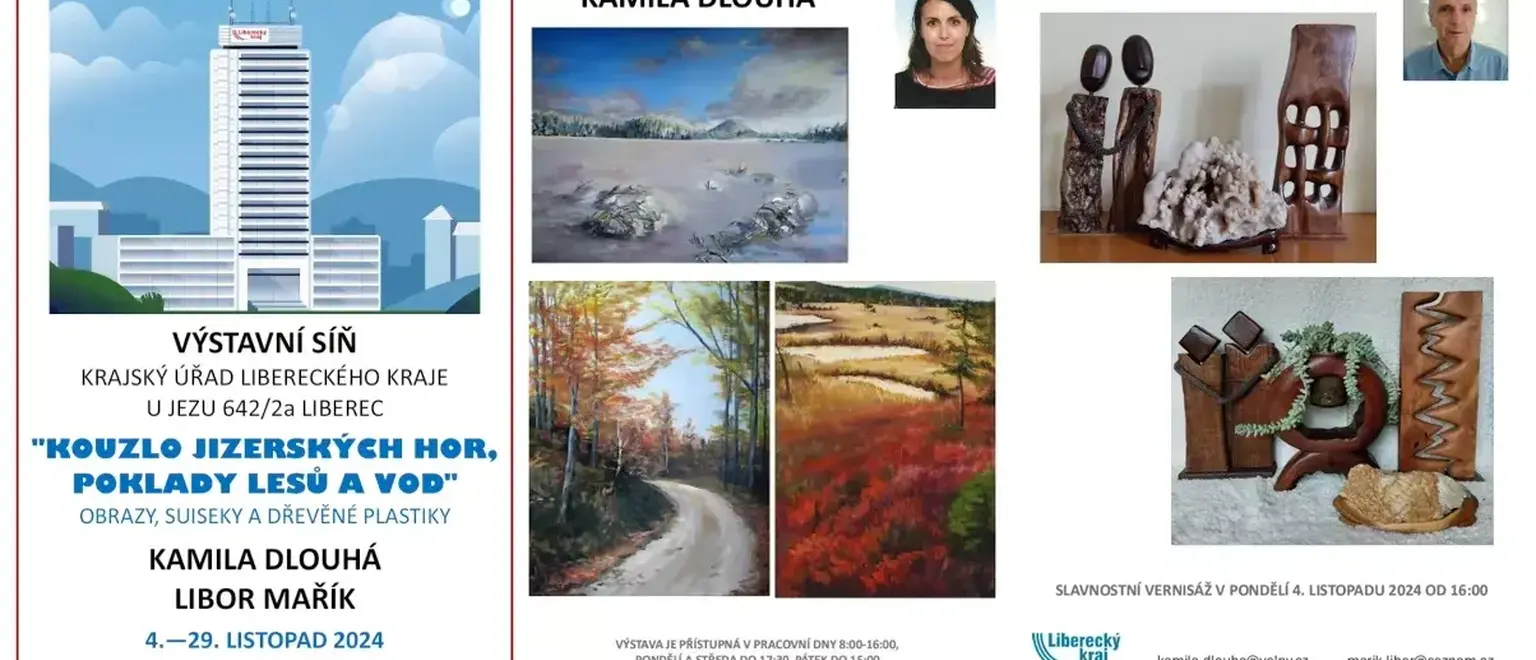Mgr. Kamila Dlouhá During my studies at UJEP I was mainly engaged in drawing and graphic arts. I am still intensively involved in realistic portrait drawing and I am still trying to improve it. Recently, however, it has become a kind of "routine" for me, and therefore for several years I have had the idea of returning to painting, which I have neglected, and trying to grasp the theme of the landscape of the Jizera Mountains. Whether out of concern for the result and the possible cheapening of materials, or out of humility towards the works of the old landscape masters, I decided to take the most ordinary, simple way possible instead of canvases and oil or acrylic paints. I made use of the available common materials and artistic means and tried to make the most of them. As a base for my paintings I used sololite boards of various sizes, on which I first applied several layers of white latex. I combined tempera paints with water-based tinted, remacol paints, which are mainly used for interior painting. The selection of brushes used also falls into the same category of painting tools. The source material was mostly my own photographs from my trips and excursions, which I enlarged several times using a square grid. It was a difficult and daring task. I consider myself an absolute amateur in painting and it was also the first time I worked on such large formats. My motivation was to create a set of paintings in which I try to capture the impossible - the magic and spirit of this precious landscape, where I love to go to discover new and new places. I belong to those "whose love for the Jizera Mountains borders on obsession", as Mr. Miloslav Nevrlý describes in the introduction to his book of photographs Jizera Mountains (1971).
Libor Mařík I first got acquainted with the Japanese art of "suiseki" at the exhibition of bonsai in the Liberec Botanical Garden. Suiseki means a visually interesting stone, preferably smoothed with water and set in a wooden base. It comes from ancient China and Japan, where "sui" means water and "seki" means stone. Natural stones are copies of objects or, with a touch of imagination, their likeness. A stone can be a reminder of the place where we found it, a certain event or person. As with bonsai, suiseki is about the miniaturization of nature. I was so captivated by this that I took trips from spring to fall, returning home with an often unwieldy backpack filled with all sorts of stones. Over the winter I would then shut myself in my workshop and set them into wooden mats. Gradually I began to concentrate on working with the wood itself. Two years ago the Liberec dam was being drained and I found a lot of interesting old wood with a story at the bottom of it. The wood itself inspires and shows what can be made from the individual pieces. So I started working it and making sculptures out of it. Some of my creations can now be seen for the first time in this exhibition.
The autumn exhibition of artists Kamila Dlouha and Libor Mařík can be seen in the lobby of the regional office on weekdays 8 am - 4 pm, Mondays and Wednesdays until 5:30 pm, Fridays until 3 pm. The vernissage will take place on 4 November at 4 pm.
Libor Mařík I first got acquainted with the Japanese art of "suiseki" at the exhibition of bonsai in the Liberec Botanical Garden. Suiseki means a visually interesting stone, preferably smoothed with water and set in a wooden base. It comes from ancient China and Japan, where "sui" means water and "seki" means stone. Natural stones are copies of objects or, with a touch of imagination, their likeness. A stone can be a reminder of the place where we found it, a certain event or person. As with bonsai, suiseki is about the miniaturization of nature. I was so captivated by this that I took trips from spring to fall, returning home with an often unwieldy backpack filled with all sorts of stones. Over the winter I would then shut myself in my workshop and set them into wooden mats. Gradually I began to concentrate on working with the wood itself. Two years ago the Liberec dam was being drained and I found a lot of interesting old wood with a story at the bottom of it. The wood itself inspires and shows what can be made from the individual pieces. So I started working it and making sculptures out of it. Some of my creations can now be seen for the first time in this exhibition.
The autumn exhibition of artists Kamila Dlouha and Libor Mařík can be seen in the lobby of the regional office on weekdays 8 am - 4 pm, Mondays and Wednesdays until 5:30 pm, Fridays until 3 pm. The vernissage will take place on 4 November at 4 pm.
Art & Exhibition
Last update 02.11.24, 17:58 o 'clock


